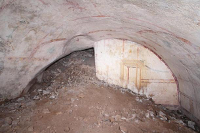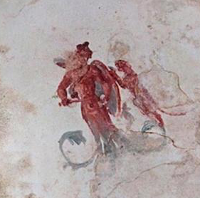|
Hidden Chamber Discovered at Nero's Golden Palace
May 11, 2019
Archaeologists have discovered a hidden chamber in the famed Domus Aurea palace of the Roman emperor Nero. The chamber had been covered since the palace was built in the 1st Century A.D. Working on a restoration project at the Colosseum heritage park, Italian archaeologists found an opening in a wall that led to a 15-foot-high underground chamber that was once connected to Nero's palace. The emperor ordered his huge, sprawling palace built beginning in A.D. 64, after the Great Fire of Rome. The concrete palace covered more than 100 acres over parts of four of Dotting the arched roof chamber are a large number of still-vivid frescoes, depicting birds, panthers, aquatic creatures, and a sphinx. One painting shows a panther attacking a weapon-wielding man. Armed centaurs feature in another painting. Other frescoes show flowers, fruits, and leaves. The god Pan is shown in a full-length portrait. The team of archaeologists reported being most impressed with the painting a sphinx, the winged mythical beast that featured, among other places, in the Greek story of Oedipus. The sphinx is shown in a crouching position. The restoration team have dubbed the chamber the Sphinx Room. Much of the chamber is still buried under rock, so restoration efforts on the newly discovered might progress slowly, archaeologists warned. |
|
Social Studies for Kids
copyright 2002–2024
David White




 Rome's seven hills, the Caelian, Esquiline, Oppian, and Palatine. Illustrating the emperor's power and wealth were lavish gardens and an artificial lake. The palace was so extravagant that it was known as the Golden House. Subsequent emperors tried to erase as much as they could of Nero's famed palace, including Trajan, who covered it with dirt on top of which baths were built, and Vespasian, who covered the artificial lake with an amphitheater.
Rome's seven hills, the Caelian, Esquiline, Oppian, and Palatine. Illustrating the emperor's power and wealth were lavish gardens and an artificial lake. The palace was so extravagant that it was known as the Golden House. Subsequent emperors tried to erase as much as they could of Nero's famed palace, including Trajan, who covered it with dirt on top of which baths were built, and Vespasian, who covered the artificial lake with an amphitheater.


